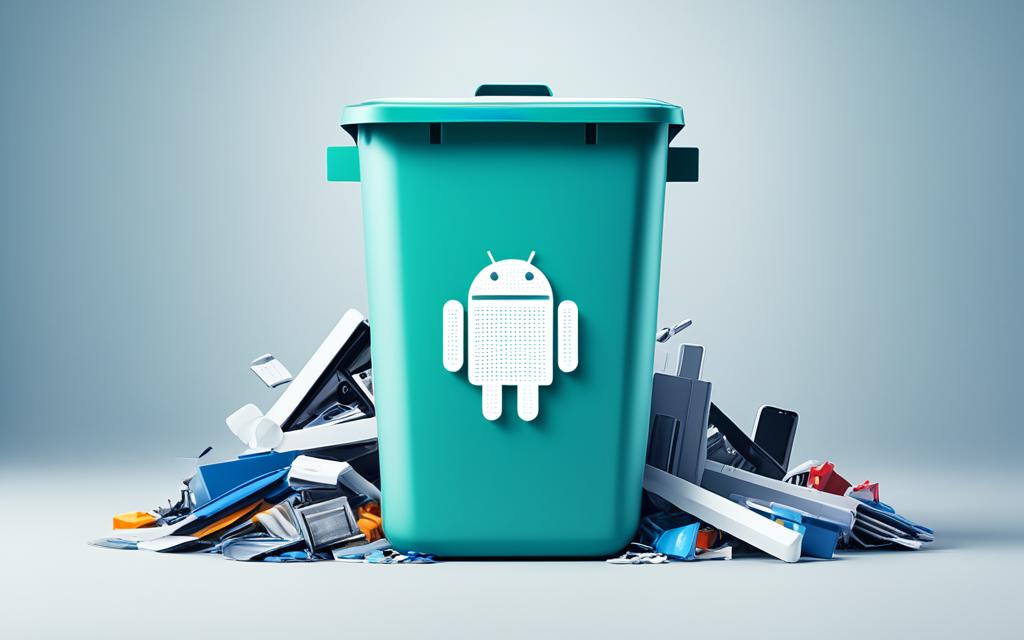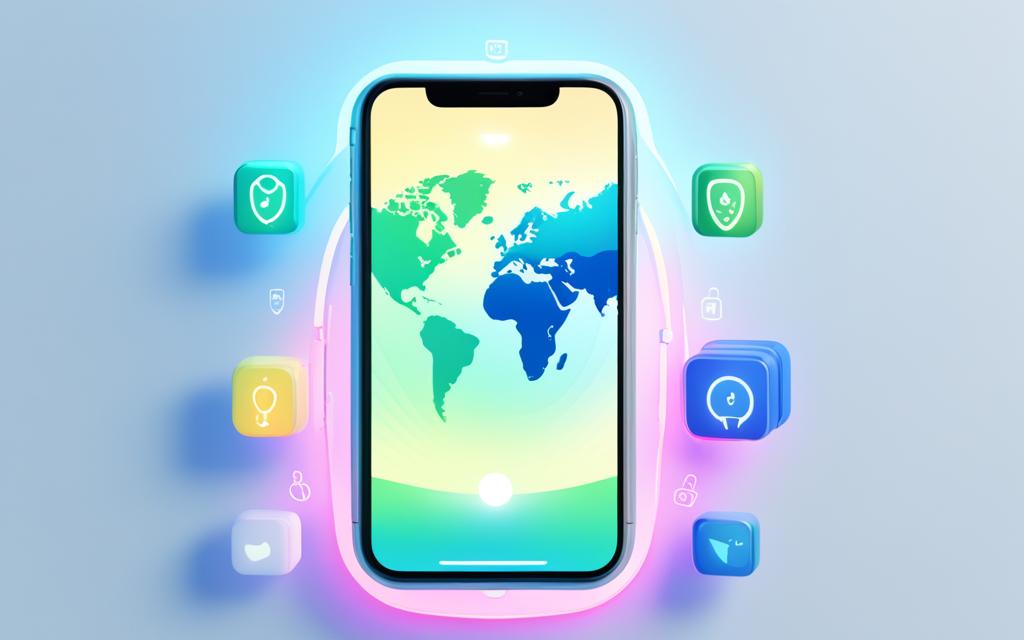How to Empty Trash on Android: Quick Guide
How to Empty Trash on Android – Here, we’ll walk you through clearing your Android’s trash. This process is vital for managing your storage effectively. It’s great for freeing up space or making sure deleted files are really gone.
Many Android users end up with lots of deleted files. These files sit in the device’s trash, using up space. Luckily, it’s easy to empty the trash. This clears space and keeps your device tidy.
Understanding Android’s Trash
Being an Android user often means managing device storage. An important part is knowing about the Android Trash, also called the Recycle Bin. This is a spot for deleted files. They stay there before they’re gone for good.
What is the Android Trash?
The Android Trash is where deleted files go before they are completely removed. It’s like a safety net. This lets you get back files you delete by mistake. But, remember, the Trash uses device storage if not handled right.
How Files End Up in the Trash
When you delete a file on Android, it isn’t gone right away. It moves to the Trash. Files stay there until you delete them for good or the device clears the Trash. This is to avoid losing important data by accident. But, the Trash can pile up, taking up space on your device.
Knowing about the Android Trash can help with managing your device’s storage. This way, you can free up space and get rid of what you don’t need. Controlling your Trash means a better running device.
Reasons to Empty the Trash on Android
Emptying the trash on your Android is key to keeping your device clean and organized. It ensures that our devices work well and have enough space for new stuff.
Here’s why it’s important to clear the Android trash:
- Freeing up storage space: Deleting files and apps puts them in the trash. This can take away a lot of your storage. By emptying the trash, you get to use this space again.
- Permanent file deletion: If you delete a file from the trash, it’s gone for good. This means private or unwanted data is removed, making your device more secure.
- Improved device performance: An overloaded trash can slow your device. This happens as it keeps track of all those unwanted files. Clearing the trash helps your device run faster.
- Organized file management: An empty trash means your device stays neat. It helps you quickly find what you’re looking for among your files and content.
Get into the habit of regularly emptying your Android trash. This simple task boosts storage, security, and your device’s operation. It’s a great way to keep your phone or tablet in top shape.
How to Empty Trash on Android
Step-by-Step Guide to Clear Android Trash
Keeping your Android’s trash clean is key to good storage and performance. Follow these steps to clear your trash and free up space.
First, find and open the Trash or Recycle Bin on your Android. You can do this from the Files app or a specific Trash app.
Next, look through what’s in your Trash. Make sure you really don’t need any of these items before you delete them for good.
Then, choose what you want to get rid of. You can select more than one item to delete at the same time.
Finally, hit ‘Empty’ or ‘Delete’ to get rid of those files or folders. Remember, once you empty it, there’s no going back.
Make sure you’re certain you don’t need anything in the Trash before you clear it out.
| Action | Steps |
|---|---|
| Delete files from Android Trash |
|
| Clear Android deleted items |
|
| Remove Android deleted items |
|
Following these steps will easily clear your Android trash. This helps free up space on your device. Always check what’s in your Trash first to keep any important files safe.
Permanently Deleting Files from Android
Emptying the Trash just removes files temporarily. Let’s learn how to delete files forever from your Android. This ensures they’re gone and don’t use up your memory.
Confirming Permanent Deletion
Deleting a file doesn’t mean it’s gone for good on your Android. It first goes to the Trash. There, the file sits until you delete it permanently. Here’s how to make sure files are gone forever:
- Open the Trash on your Android device.
- Select the files you want to permanently delete.
- Tap the “Delete” or “Permanently Delete” button.
- Confirm the action to permanently remove the files from your device.
This process clears the Trash, freeing up your storage. Remember, once files are permanently deleted, you can’t get them back. So, only delete what you’re sure you don’t need.
Deleting files from the Trash helps keep your Android device neat. It turns storage space from waste to use. This is key for devices with little room or if you’ve stored many files you don’t need.
Deleting files for good keeps your Android clean and organized. It ensures your device runs well and has space for new memories.
Freeing Up Space on Your Android Device
Emptying your trash is key to getting more storage on your phone. There are more ways to keep your Android running well by managing storage. We’ll look at tips to free up space on your phone or tablet.
Identify and Delete Unused Apps
Finding and removing apps you don’t use anymore can free up space. Check your apps and delete the ones you haven’t used for a bit. This step helps to free up space on android and boosts your phone’s speed.
Clear Cache and Data
Apps keep cache and data that fill up your storage. You can get rid of these files in your Settings under “Apps.” Clearing them helps you manage storage better.
Offload Files to Cloud Storage
- Use Google Drive, Dropbox, or OneDrive to store photos and videos in the cloud. It makes more space on your device.
- Turn on automatic backup to save your files in the cloud regularly. It makes them easy to delete from local storage.
Optimize Your Photos and Videos
Free up space on android by managing your photos and videos:
- Make photos and videos smaller by compressing them.
- Delete photos and videos you don’t need or that are blurry often.
- Use Google Photos or another cloud storage service. It lets you have fewer files on your device.
Using these methods helps you keep your Android running well by android manage storage better. You’ll get back space and enjoy your device more.
Managing Storage on Android
Keeping your Android device running smoothly means managing storage well. Smartphones and tablets fill up with files, apps, and media. It’s key to keep the storage in check to avoid slow downs.
We’ll show you how to make more space on your Android. This includes handling apps and using cloud storage.
Tips for Optimizing Android Storage
Running out of storage can mess with your device’s performance. Here’s how you can make things better:
- Regularly review and remove unused apps. Choose the ones you don’t need and delete them. This move can open up a lot of space.
- Apps often collect a lot of cache and data. Cleaning these out can help. Go to the app’s settings, then clear the cache or data.
- Cloud storage is a helpful tool. Services like Google Drive let you keep your files somewhere else. This way, they don’t eat up your device’s storage.
- Back up your photos and videos. You can use a cloud service or your computer. Then, you can delete them from your device.
- If you have large files you don’t need, get rid of them. Videos, for example, can take up a lot of space. Deleting them can free up storage.
By following these steps, you can ensure your device stays in top shape. Keeping your Android organized and performing well is achievable.
To keep your Android storage working well, you must stay on top of it. Regular checks and actions will help you avoid problems. This way, your device will run just as expected, providing the best experience.
Preventing Trash Buildup on Android
It’s critical to keep your Android device clean and well-organized. This is key for it to run smoothly and store things properly. We will show you how to stop unwanted files from piling up in the Android Trash. This way, you can manage your device’s storage wisely.
Always make it a habit to clear your Trash often. This simple step allows you to free up space. Plus, it prevents your device from getting slow because of unnecessary files.
When deleting files, take a moment to think about it. Ask yourself if you really need them. This mindful approach can reduce the amount of junk in your Trash. It also cuts down how often you have to clean it out.
You should also use the storage tools in your Android device. They can help you keep an eye on your storage use. With this, you can spot and remove items you don’t need. That way, your Trash won’t get cluttered.
For better storage management, try the tips below:
- Regularly review and delete big files or apps you don’t use anymore
- Use cloud storage to store files elsewhere and clear up your local storage
- Set up automatic Trash emptying so you don’t have to remember to clear it
- Organize your files to make searching and managing them easier
By using these methods, you can keep your Android device clean and efficient. This leads to a better, faster, and hassle-free experience on your mobile.
Alternatives to the Android Trash
The Android Trash is great for managing deleted files. But, sometimes, you might want other ways to handle this. Let’s check out some top alternatives and what they can do for you.
Direct File Management Apps
You can try using special file manager apps instead of the Android Trash. Apps like ES File Explorer or Solid Explorer let you delete files permanently. This is good if you want full control over deleting files.
Cloud Storage Solutions
Storing your files in cloud services like Google Drive or Dropbox is another choice. This way, you can manage your phone’s storage without using the Trash. Deleting files from cloud storage means they’re gone for good, skipping the Trash step.
Third-Party Trash Managers
Apps like Dumpster or Trash Cleaner offer more features for managing the Trash. They let you see and restore deleted files, set up automatic cleaning, or delete Trash files forever easily.
Choosing the right method for file management on your Android device depends on what you prefer and need. Exploring these different options helps find what works best for you.

Conclusion
We showed you how to empty the Trash on your Android with this in-depth guide. Now, you know why the Trash exists and how to clean it up. This will help you manage your storage better and keep your device fast.
It’s key to keep your Android Trash neat for it to work well. This means making space, not letting things pile up, and removing what you don’t need carefully. By doing this, you make your Android work better for you.
The Android Trash is a safety feature that saves your mistakenly deleted files. But don’t forget to take out the Trash now and then. This prevents it from taking up space you might need later. Just follow our guide to clear your Android Trash. Your device will be more tidy and work smoother as a result.




